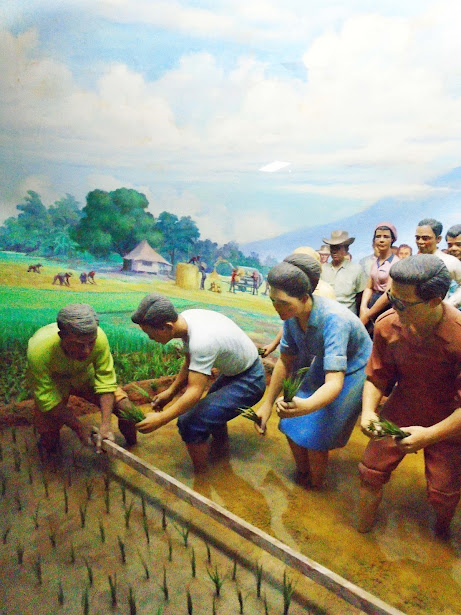Food Crisis Series 10:
Men behind Philippine food self-sufficiency
and rice exportation
Remembering Philippine Agriculture
Secretary Arturo R Tanco Jr
He brought into international limelight Philippine Agriculture, for which he was recognized by the World Food Council and became its president.
He also promoted the International Fund for Agricultural Development , and helped
found the Southeast Asia Research Center for Agriculture. He served as director of the International Rice Research Institute.
Dr Abe V Rotor*
Agriculture is often referred to as backbone of the economy. Indeed, food shortage may lead to hunger, consequently stirring unrests that undermine our society.
He helped found the Southeast Asia Research Center for Agriculture and was a director of the International Rice Research Institute, based at Los Banos, Laguna.
Mr. Tanco had a son and two daughters with wife Patricia. (The New York Times) ~
Address: NFA Building, Maharlika Highway, Cabanatuan City, Nueva Ecija
Landline +63 (44) 958 9697
Agriculture is often referred to as backbone of the economy. Indeed, food shortage may lead to hunger, consequently stirring unrests that undermine our society.
On the other hand, agriculture the cradle of civilization as history tells us, is the principal guarantee of peace and progress.
This is the foundation of Secretary Tanco's philosophy: to attain self-sufficiency and affordability of food. Subsequently, to raise the category of the country as a net grain exporter, other agricultural products - like sugar, fruits, food oil, not notwithstanding.
And he succeeded! Thus he earned for the Philippines, then a "Phoenix Bird" rising from the ashes of the global food crisis, so to speak, a singular honor which many countries used as model for their own agricultural programs. Vietnam which we helped in its crisis is now a rice exporter. And in disbelief, Vietnam is now a regular rice exporter to the Philippines to augment our annual deficit after Tanco's time by no less than ten percent of rice requirement. Thailand whose students came to learn agriculture from us is consistently the number one rice exporter to us.
Secretary Tanco (center) briefs members of the National Food and Agriculture Council. (NFAC), a 22-member council that catapulted the Philippines to self-sufficiency in food, through Masagana 99 (rice) Maisan 77 (corn), Gulayan ng Bayan (People based Green Revolution in fruits and vegetables), among other programs like Bakahan Barangay (livestock), and Palay-isdahan (rice-fish production).
Secretary Tanco and other officials report to President Ferdinand Marcos, the progress of the crash program on food production which broke previous records within a year, a feat heretofore unparalleled.
Today in Philippine history, April 19, 1985
Untimely Demise of Agriculture Minister Arturo R. Tanco Jr.
Arturo R. Tanco Jr., a former president of the World Food Council of the United Nations and his country's Agriculture Minister for 13 years, died today. He was 51 years old.
Mr. Tanco joined the Philippine Government in 1970, after postgraduate studies in management at Cornell and Harvard Universities.
In 1971 he became Agriculture Minister, with special responsibility for increasing the production of rice, corn and vegetables. Under his management, the Philippines overcame a chronic rice shortage and became a rice exporter. He used print and electronic advertising to encourage farmers to use intensive cultivation. He was Agriculture Minister until last year, when he resigned after his election defeat.
Mr. Tanco was elected president of the World Food Council in 1977 and served until 1981. He also promoted the International Fund for Agricultural Development, believing it to be an answer to cyclical food shortages.
In 1971 he became Agriculture Minister, with special responsibility for increasing the production of rice, corn and vegetables. Under his management, the Philippines overcame a chronic rice shortage and became a rice exporter. He used print and electronic advertising to encourage farmers to use intensive cultivation. He was Agriculture Minister until last year, when he resigned after his election defeat.
Mr. Tanco was elected president of the World Food Council in 1977 and served until 1981. He also promoted the International Fund for Agricultural Development, believing it to be an answer to cyclical food shortages.
He helped found the Southeast Asia Research Center for Agriculture and was a director of the International Rice Research Institute, based at Los Banos, Laguna.
Mr. Tanco had a son and two daughters with wife Patricia. (The New York Times) ~
-----------
Dr Rotor worked under Secretary Tanco as council secretary of the National Food and Agricultural Council, and chief Agricultural Projects Coordinator. He initiated the founding
of the Grains Industry Museum.
Grains Industry Museum - Showcase of the crowning glory of Philippine agriculture in dioramas and artifacts.
The Grains industry Museum was closed down following the Edsa Revolution, and re-opened 30 years later on the initiative of the present administration. The museum is located at NFA Regional Office in Cabanatuan City. It is open to the public on arrangement with NFA Cabanatuan. (Open in this blog avrotor.blogspot.com GRAINS INDUSTRY MUSEUM RE-OPENED AFTER 30 YEARS
Landline +63 (44) 958 9697
Grains Industry Museum of the National Food Authority features Secretary Tanco in dioramas: Top, Masagana 99 with President Marcos, First Lady Imelda Marcos, and NFA Administrator Jesus T Tanchanco; Lower photos: Diorama depicting rice culture in the Cordillera applying the new technology on the ancient terraces; defunct Encomienda system replaced by the present Agrarian Reform, a key factor in Masagana 99 program. ~








No comments:
Post a Comment